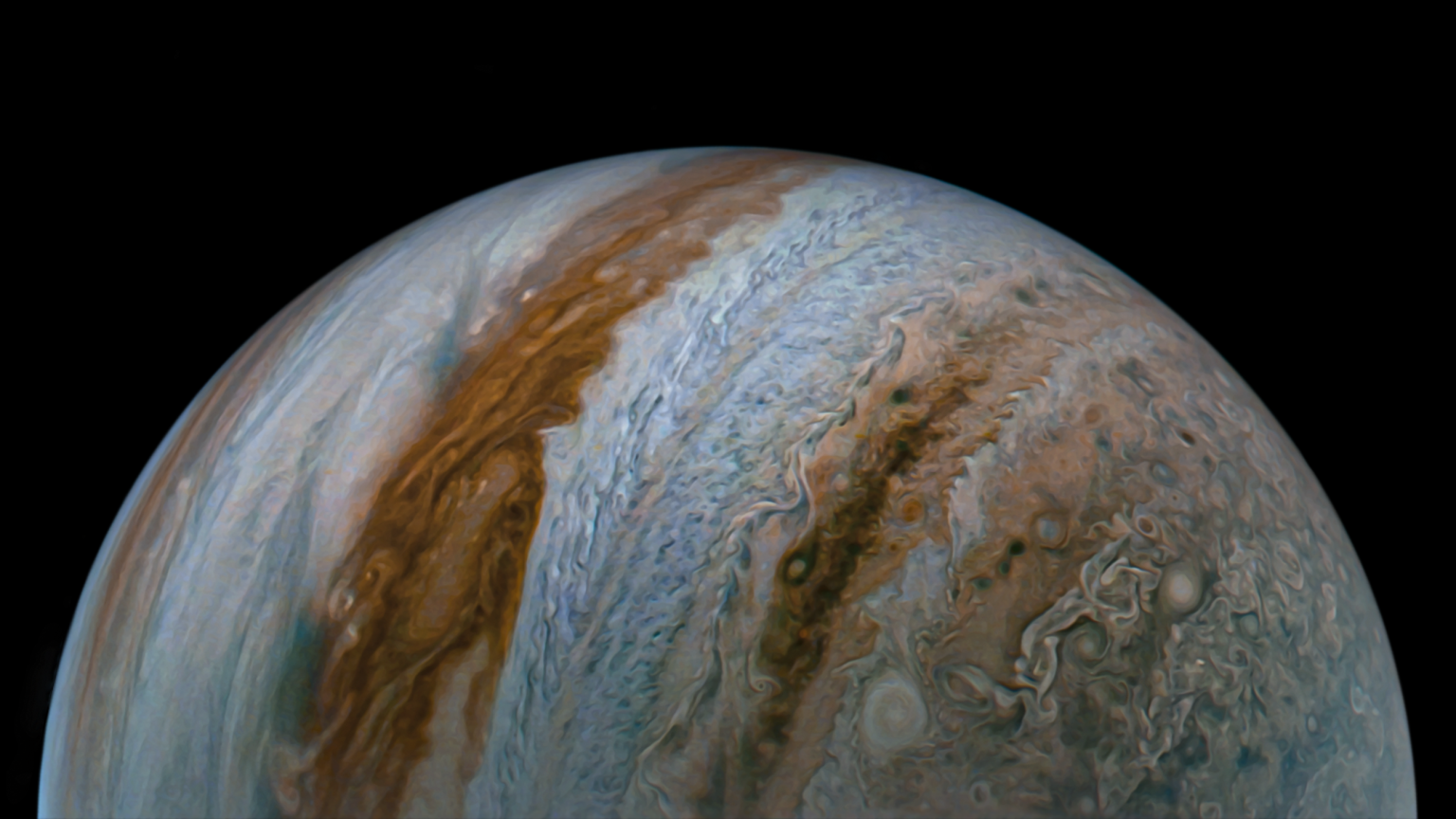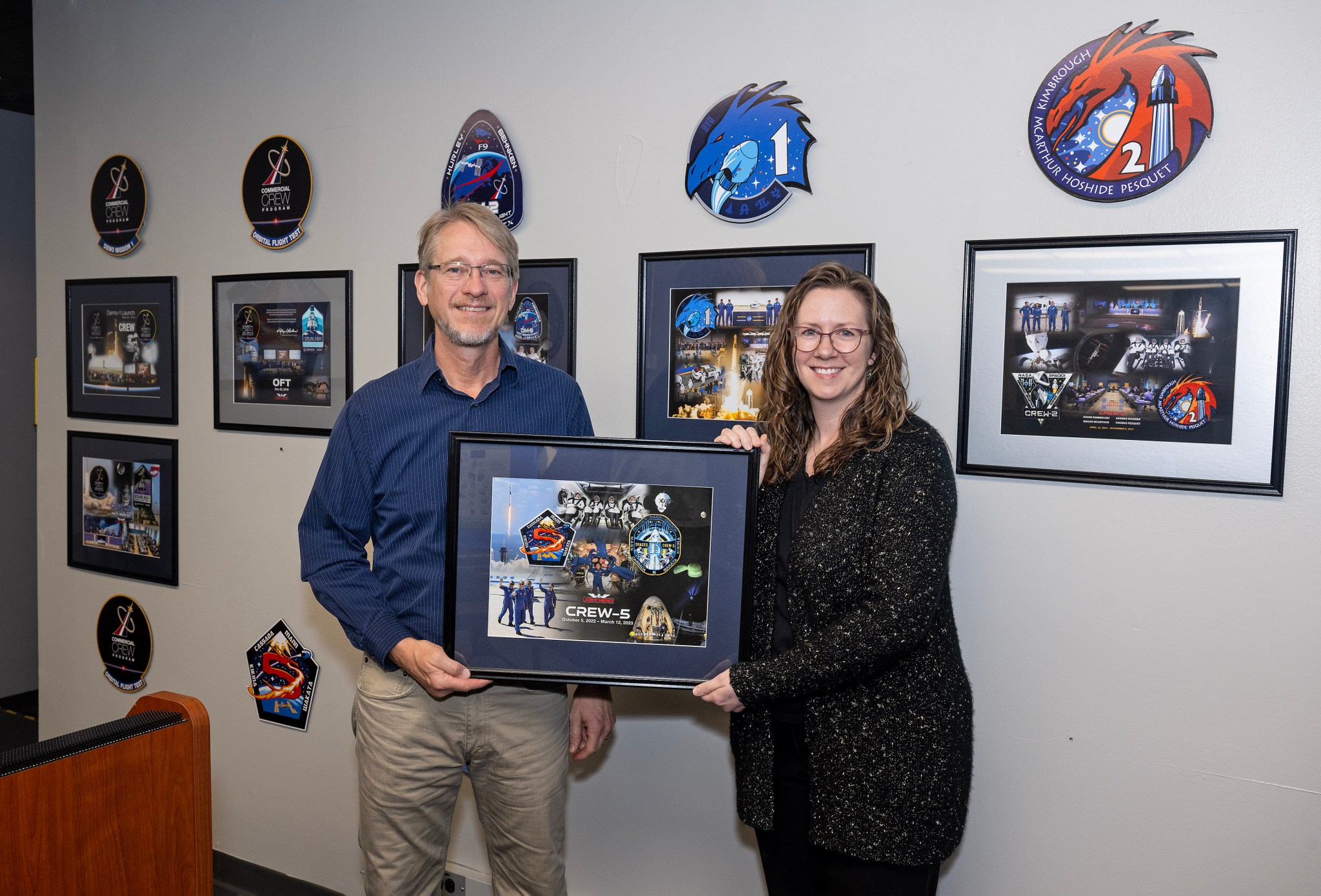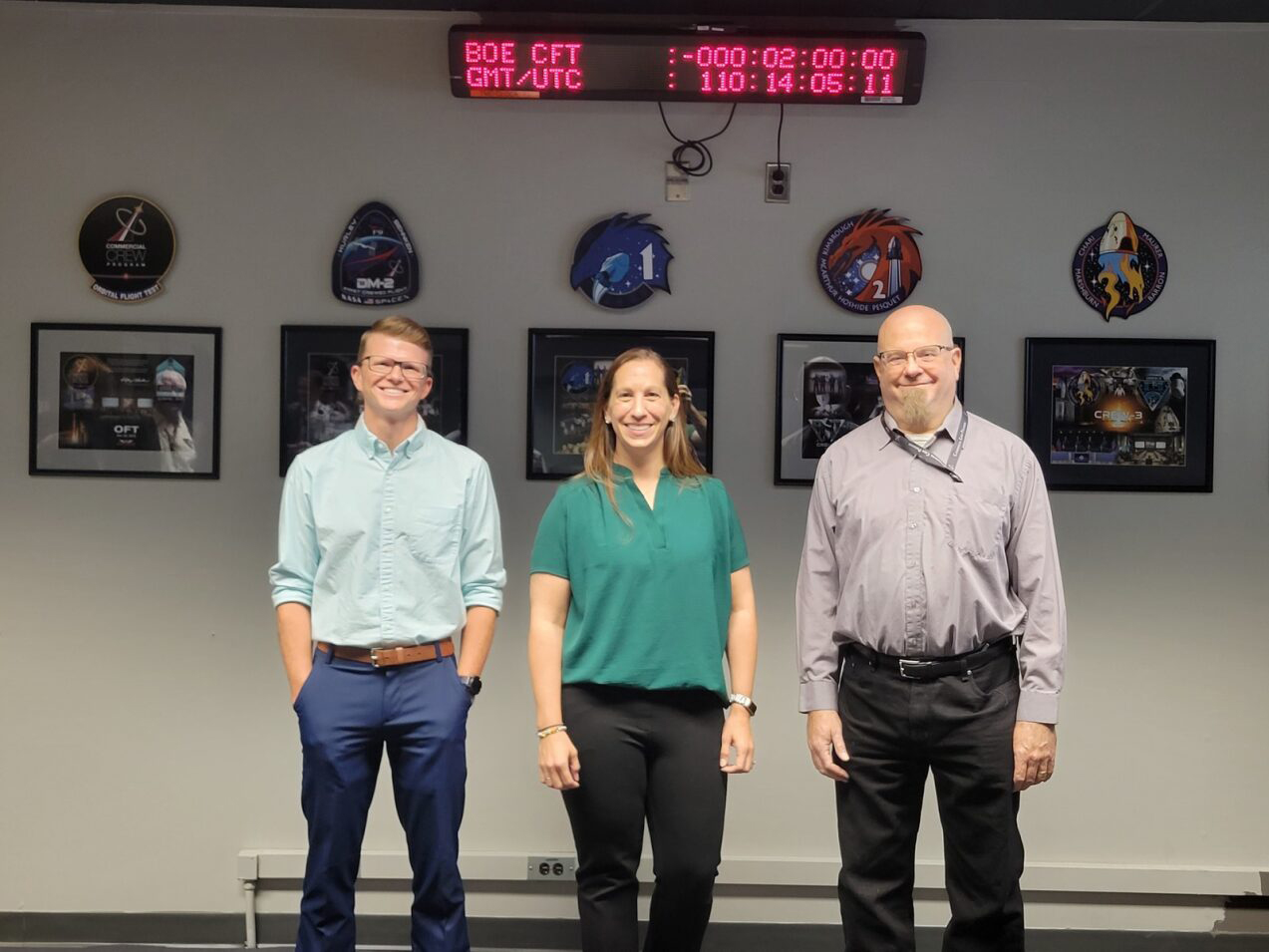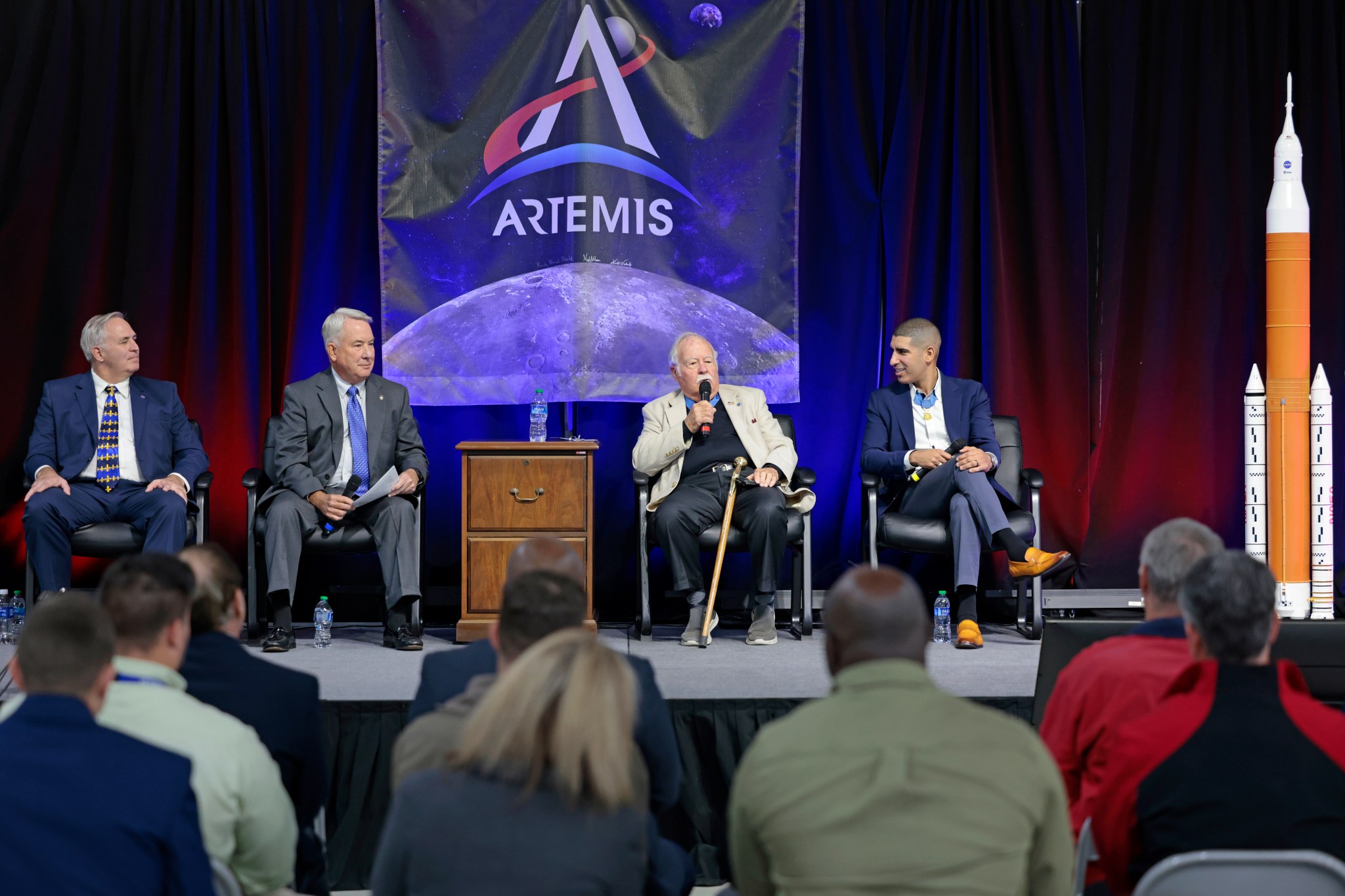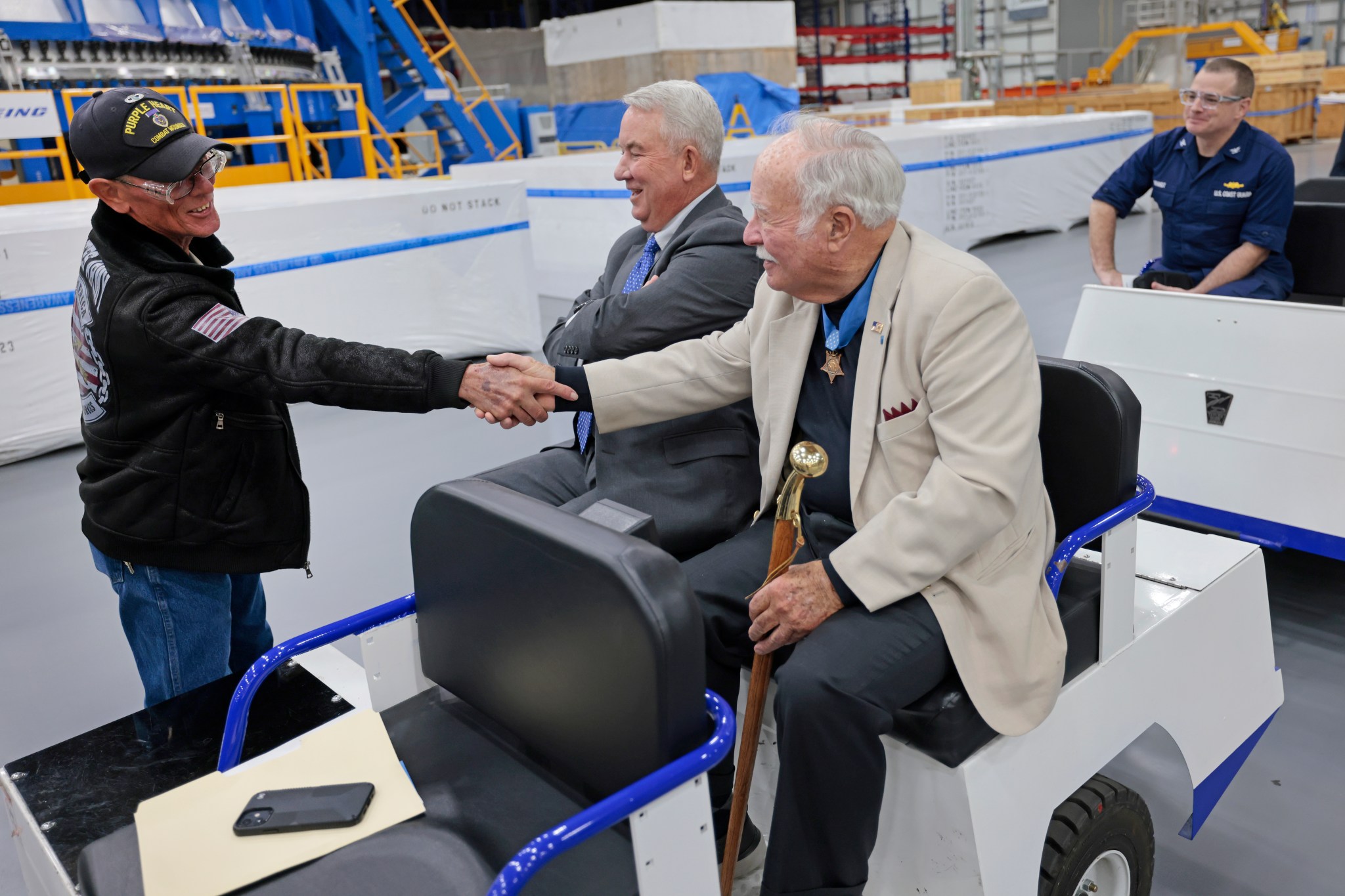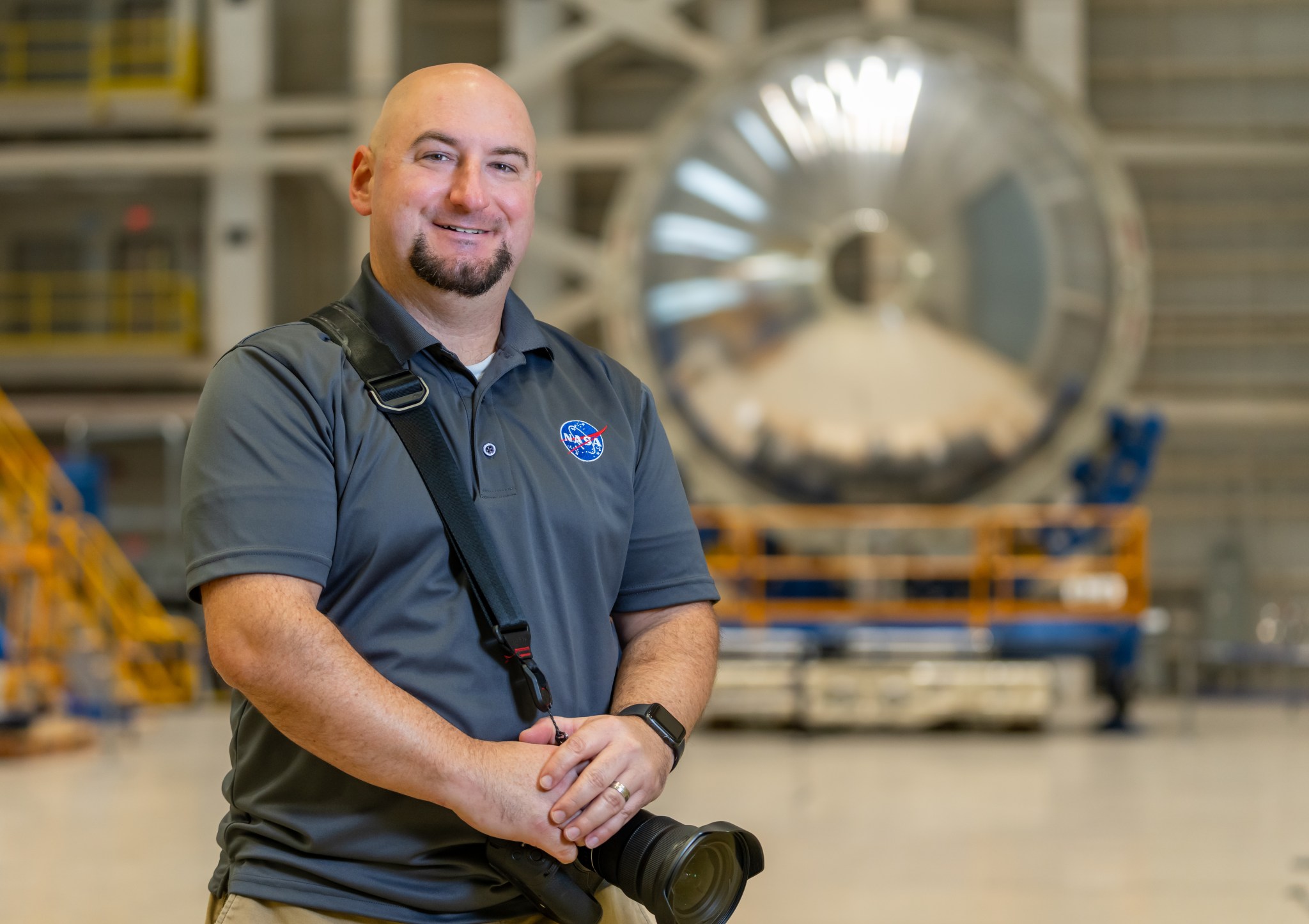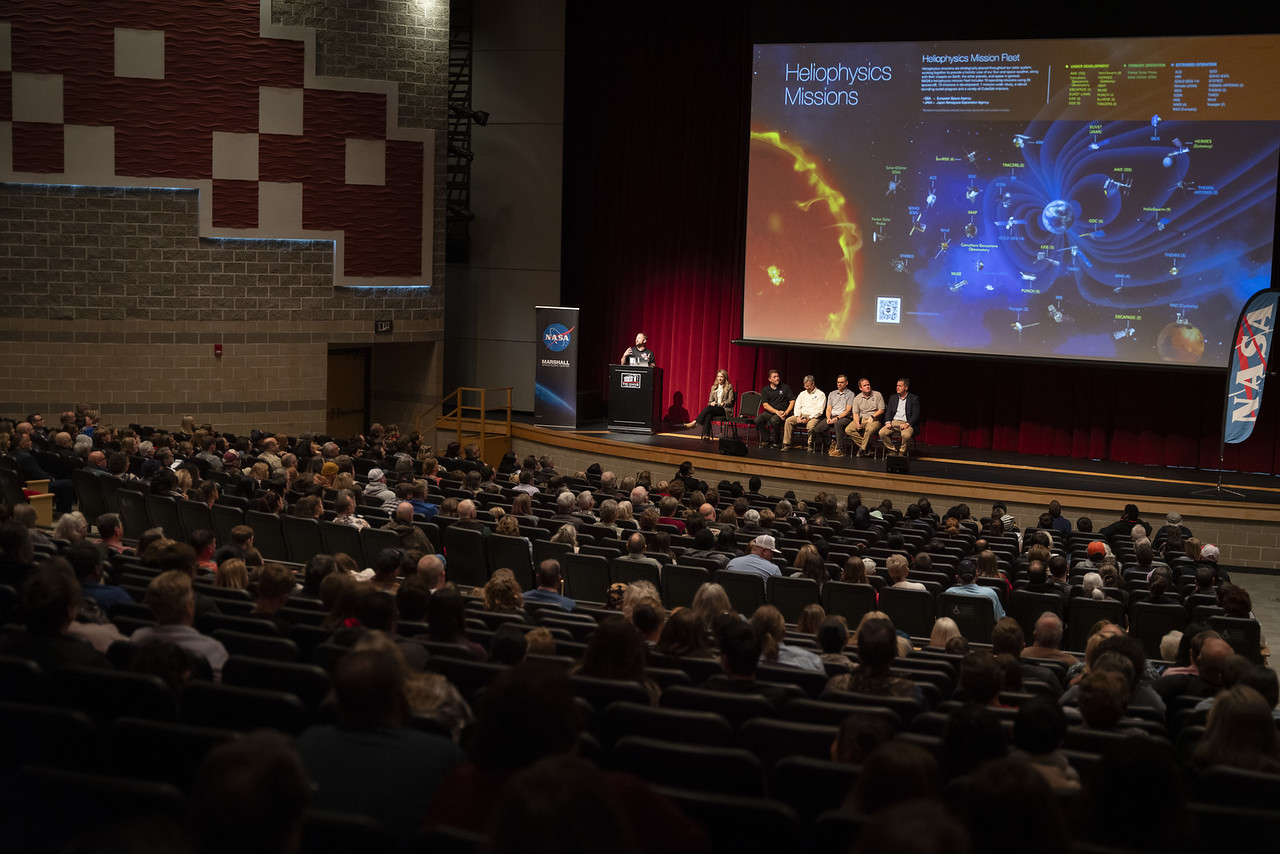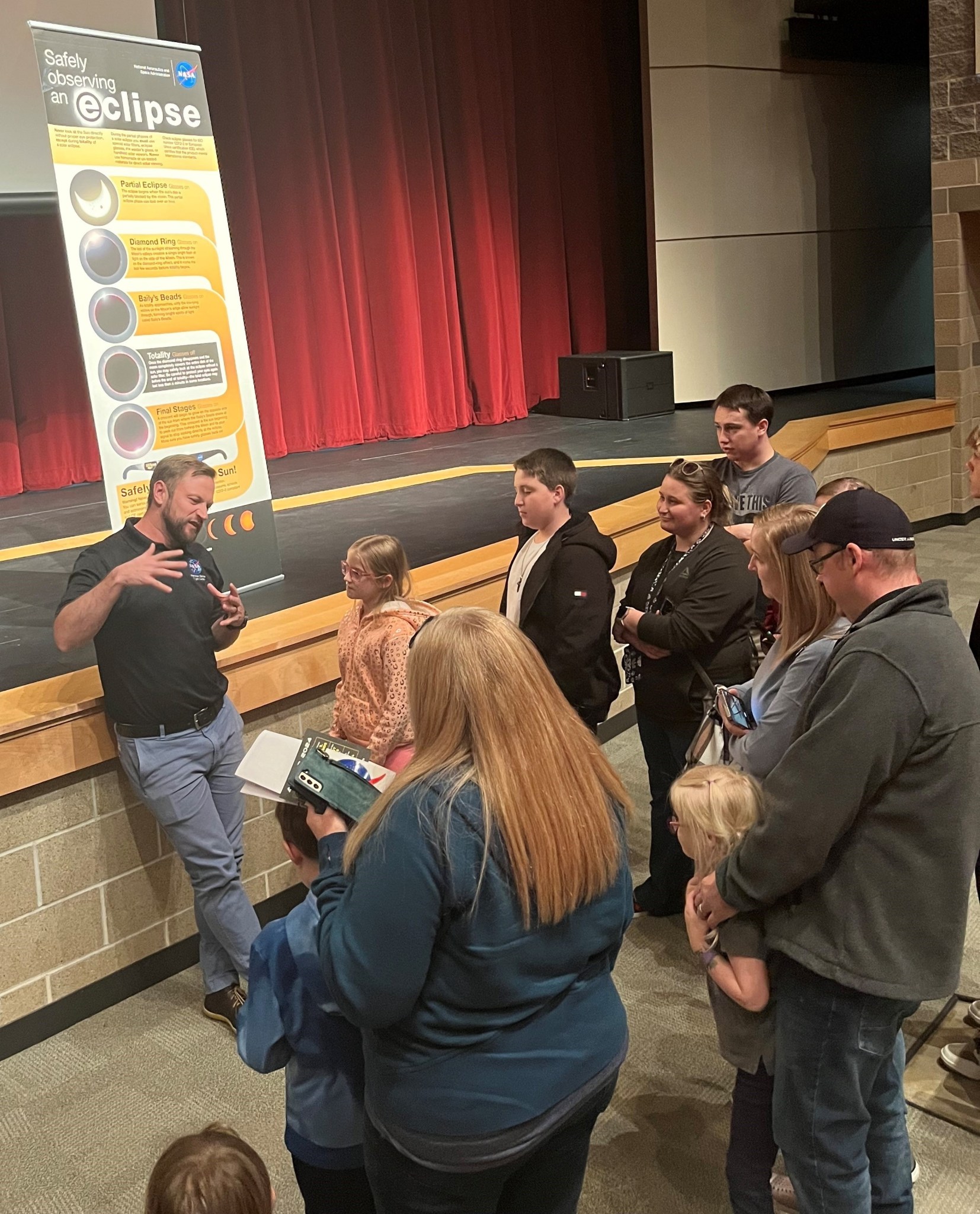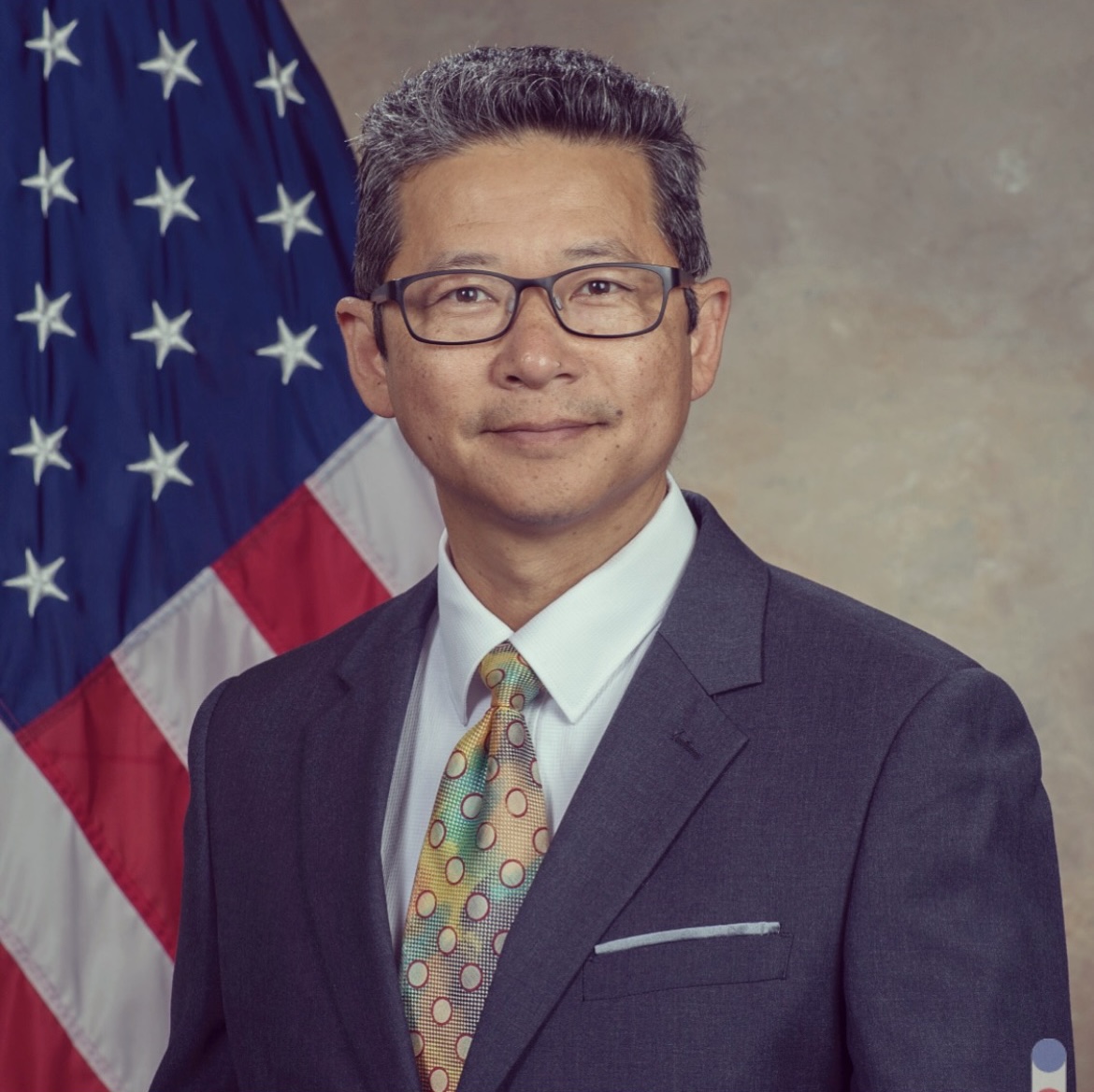Commercial Crew Program’s Plaque Hanging Tradition Continues, Celebrating Work Done by Marshall Team
By Celine Smith
NASA’s Marshall Space Flight Center participated in a new tradition last December to honor engineers for their exceptional efforts on CCP (Commercial Crew Program) missions to the International Space Station, and again Nov. 13 with a third plaque hanging at the HOSC (Huntsville Operations Support Center).
Team members are nominated at Marshall, Johnson Space Center, and Kennedy Space Center – centers that support CCP – to hang the plaque of the mission they supported. David Gwaltney, LVSO (Launch Vehicle Systems Office) technical assistant, was selected to hang the plaque for Crew-5, and Jonathan Carman, deputy SpaceX Falcon 9 lead engineer, was selected to hang the plaque for Crew-6. The Crew-5 mission launched in October of 2022. Crew-6 launched earlier this year in March.
Gwaltney was chosen for the support he provided as a technical assistant for LVSO on the Crew-5 mission. While hardware for the mission was in transit it was damaged. He was critical to ensuring the proper inspections and analysis were completed. He then relayed the risk assessments to the program for acceptance. Gwaltney’s expertise led him to accurately pinpoint major areas of risks and understand them for a successful mission.
“We had good communication lines and an experienced team that allowed us to be ready for what we needed to do,” Gwaltney said.
Crew-5 was the first CCP mission to be led by a female commander, Nicole Mann. Mann also became the first indigenous woman to fly with NASA. Anna Kikina became the first Russian cosmonaut to fly on a U.S. commercial rocket during this mission as well.
Carman was recognized for his coordination of the second launch attempt for the Crew-6 mission that took place during a severe weather warning at HOSC. Carman took preventative measures to ensure the launch was a success. He collaborated with Mission Management and Integration, HOSC personnel, and the Marshall support team. He relocated the launch operations team to the storm shelter while preserving open lines of communication.
“It’s an honor to have people count on me to take on the role and have trust in me,” Carman said. “I learned that good coordination and teamwork is always a recipe for success.”
The launch of Crew-6 was the first time a Crew Dragon capsule was reused for a fourth time. The mission also featured the first United Arab Emirates astronaut.
“Both Dave and Jonathan have consistently gone above and beyond to meet the need and make sure that the crew has a safe flight to station,” said Lisa McCollum, Marshall’s CCP LVSO deputy manager.
The second plaque hanging took place at HOSC on April 20 earlier this year. Ken Schrock, an avionics system engineer, hung the plaque for the Crew-3 mission, Patrick Mills, liquid propulsion systems engineer, hung the Crew-4 plaque, and Megan Hines, system safety engineer, hung the OFT-2 plaque.
Schrock was selected for critically assessing autonomous flight termination system test products and analyzing their reports for the Crew-3 mission. He also monitors Falcon 9 fleet launches for any issues that could be applicable to other CCP missions.
Mills was honored with a plaque hanging for his repair work on Falcon 9’s first stage booster for its fourth launch on the Crew-4 mission. After static fire, the team identified repairs that would be needed before flight. Mills played a key role in measuring the risk of the leaks caused. He led the team that decided patching them would be a suitable resolution preventing any spraying during the engine start up.
Hines was recognized for her safety and mission assurance work on the OFT-2 mission. Due to most of the team being focused on the reused components in the Crew-4 mission, Hines coordinated all the OFT-2 safety and mission assurance work. During the mission she provided support on-console during the launch. The flight met all test objectives, completing the first docking of the Starliner to the space station.
“I’m really proud of this team and how much work, heart and effort goes into each flight,” McCollum said. “It’s important for the folks across the agency and the public to know what our team is doing behind the scenes to make these missions happen.”
Smith, a Media Fusion employee, supports the Marshall Office of Communications.
National WWII Museum Brings Valor Outreach Event to Michoud Veterans
By Heather Keller
Veterans from the multi-tenant workforce at NASA’s Michoud Assembly Facility attended a panel discussion featuring two Congressional Medal of Honor recipients Nov. 1 in Michoud’s Hero’s Way – a hall lined with the mission patches for every NASA mission, along with crew photos and mission details.
When the National WWII Museum in New Orleans learned they would be hosting the week-long Medal of Honor Convention in 2023, they began exploring ideas for local Valor Outreach opportunities. Michoud’s beginnings as an aircraft factory producing C-76 and C-46 cargo planes in support of WWII, in addition to its current operations supporting the space program, as well as housing multiple government agencies, including U.S. Coast Guard Base New Orleans, made it a prime location for the event.
“NASA Michoud is a foundation of the American space program and a marvel of scientific and engineering capability,” said event moderator and retired U.S. Marine Corps Gen. David Mize, who now serves as chairman of the Mayor’s Military Advisory Committee of New Orleans. “It is truly an underappreciated American jewel.”
The event afforded a unique opportunity to the attendees to be with the “heroic unicorns of the U.S. military,” according to Mize, noting, “there are about 343 million people in the U.S. … 16.2 million living veterans … two million personnel on active and reserve duty,” yet there are only 65 living Medal of Honor recipients.
The Medal of Honor recipients, retired U.S. Army Capt. Florent Groberg and retired U.S. Marine Corps Col. Harvey Barnum, Jr., visited Michoud as part of the Congressional Medal of Honor Society Valor Outreach Program. They spoke of their individual experiences serving the country in combat and in their civilian life following retirement. Topics of discussion included patriotism, leadership, and a comparison between the foreign affairs from WWII to today, among others. The pair fielded questions from the audience, which was exclusively made up of Michoud veterans, and those currently serving onsite at USCG Base New Orleans.
Both panelists spoke on the weight of the medal, and the struggle of being celebrated as a war hero while their comrades gave the ultimate sacrifice.
“The medal is not ours,” said Groberg, a veteran of the War on Terrorism. “We’re recipients of the medal. We’re a courier of the medal. There’s a story behind each and every one of our medals, that include many, many other people aside from us. Now we have a platform to tell those stories.”
Groberg continued with the names of the four soldiers who lost their lives in Afghanistan on the day he earned his accolade, a personal mission he’s adopted to honor their memory.
Barnum, a veteran of the Vietnam War, spoke about the 365 Medal of Honor recipients who were alive when he was decorated in 1967. At that time there were honorees who served as far back as the Banana Wars of the 1890s, who became his mentors, and taught him the importance of being a caretaker of the medal. He compared the honor to a brotherhood, saying they have all become family.
“Many of us go to the White House when a new recipient is awarded, and then we also gather at Arlington when we say ‘goodbye,’” Barnum said. “It’s the greatest fraternity that anybody could ever be a member of.”
To Groberg and Barnum, the greatest honor is knowing that their peers nominated them for the recognition, though they noted one aspect where the society falls short. “We need a woman,” Groberg said. “We had some women that went out who walked the walk with us, they fought with us, they did some incredible work, and some of them didn’t come home.”
Drawing on their experience, Groberg and Barnum urged their fellow veterans to talk about their experiences and recalled how opening up to those around them aided in both their physical and emotional recovery.
When asked if they would do it all over again by a Michoud employee, both men agreed they would, without hesitation; however, when asked if they would ever consider going to space, they had a difference of opinion.
“Not me,” Barnum said. “I’ve always wondered why people jump out of good airplanes.”
Groberg, a former Boeing employee said, “A hundred percent… this is the future …especially with ya’ll building the rockets. Count me in.”
Following the panel discussion, the Medal of Honor recipients enjoyed a lunch with Michoud leadership, a small contingency of Michoud veterans, and USCG personnel. Finishing out the day, the WW II staff and Medal of Honor recipients enjoyed a tour of America’s rocket factory while engaging MAF veterans along the tour route.
Keller, a Manufacturing Technical Solutions Inc. employee, works in communications at Michoud Assembly Facility.
Greg Chavers Named Strategic Architect, Integration Manager of Marshall’s Science and Technology Office
Greg Chavers has been named as the strategic architect and integration manager in the Science and Technology Office at NASA’s Marshall Space Flight Center.
Chavers is returning to Marshall following his role as Mars Campaign Office director in the Moon to Mars Program Office, Exploration Systems Development Mission Directorate, at NASA Headquarters from April to November 2023. In that role, he led risk reduction and technology development of systems that will lead to human Mars missions. The technologies are being demonstrated on the ground, in Low Earth orbit on the International Space Station, and will be demonstrated on the Moon on future Artemis missions.
Before leading the Mars Campaign Office, Chavers was director of the Technical Integration Office at headquarters, starting in 2022. In that role, he led an office consisting of about 70 civil servants and more than 50 support contractors including senior leaders and executives that influence the investments of multi-billions of dollars across all human spaceflight destinations.
In 2020, he was appointed assistant deputy associate administrator for the Human Explorations Office, Systems Engineering and Integration, also at headquarters. From 2019-2020, Chavers was deputy program manager for HLS (Human Lander Systems) at Marshall. He was formulation manager at headquarters for HLS from 2018-2019. In 2012, Chavers was named Lander Technologies project manager.
He joined NASA in 1991 in the Systems Analysis and Integration Lab in Marshall’s Engineering Directorate. Chavers spent more than 20 years in the Engineering Directorate before transitioning to project management in Marshall’s flight projects office.
A native of Flomaton, Alabama, Chavers received a bachelor’s degree in aerospace from Auburn University, and a master’s in astrophysics and a doctorate in physics from the University of Alabama.
He and his wife of 33 years, Denise, live in Decatur. They have three children and two grandchildren.
Rocket Exhaust on the Moon: NASA Supercomputers Reveal Surface Effects
Through Artemis, NASA plans to explore more of the Moon than ever before with human and robotic missions on the lunar surface. Because future landers will be larger and equipped with more powerful engines than the Apollo landers, mission risks associated with their operation during landing and liftoff is significantly greater. With the agency’s goal to establish a sustained human presence on the Moon, mission planners must understand how future landers interact with the lunar surface as they touch down in unexplored moonscapes.
Landing on the Moon is tricky. When missions fly crew and payloads to the lunar surface, spacecraft control their descent by firing rocket engines to counteract the Moon’s gravitational pull. This happens in an extreme environment that’s hard to replicate and test on Earth, namely, a combination of low gravity, no atmosphere, and the unique properties of lunar regolith – the layer of fine, loose dust and rock on the Moon’s surface.
Each time a spacecraft lands or lifts off, its engines blast supersonic plumes of hot gas toward the surface and the intense forces kick up dust and eject rocks or other debris at high speeds. This can cause hazards like visual obstructions and dust clouds that can interfere with navigation and science instrumentation or cause damage to the lander and other nearby hardware and structures. Additionally, the plumes can erode the surface under the lander. Although craters were not formed for Apollo-scale landers, it is unknown how much the larger landers being planned for upcoming Artemis missions will erode the surface and whether they will rapidly cause cratering in the landing zone, posing a risk to the lander’s stability and astronauts aboard.
To improve its understanding of plume-surface interactions, also known as PSI, researchers at NASA’s Marshall Space Flight Center have developed new software tools to predict PSI environments for NASA projects and missions, including the Human Landing System, Commercial Lunar Payload Services initiative, and future Mars landers. These tools are already being used to predict cratering and visual obscuration on upcoming lunar missions and are helping NASA minimize risks to spacecraft and crew during future landed missions.
The team at Marshall recently produced a simulation of the Apollo 12 lander engine plumes interacting with the surface and the predicted erosion that closely matched what happened during landing. This animation depicts the last half-minute of descent before engine cut-off, showing the predicted forces exerted by plumes on a flat computational surface. Known as shear stress, this is the amount of lateral, or sideways, force applied over a set area, and it is the leading cause of erosion as fluids flow across a surface. Here, the fluctuating radial patterns show the intensity of predicted shear stress. Lower shear stress is dark purple, and higher shear stress is yellow.
These simulations were run on the Pleaides supercomputer at the NASA Advanced Supercomputing facility at NASA’s Ames Research Center over several weeks of runtime, generating terabytes of data.
NASA is showcasing 42 of the agency’s computational achievements at SC23, the international supercomputing conference, Nov. 12-17, in Denver, Colorado. For more technical information, visit: https://www.nas.nasa.gov/sc23.
Used for this research, the framework for the Descent Interpolated Gas Granular Erosion Model, or DIGGEM, was funded through NASA’s Small Business Innovation Research program within NASA’s STMD (Space Technology Mission Directorate) in Washington, and by the Stereo Cameras for Lunar Plume Surface Studies project that is managed by NASA’s Langley Research Center, also funded by STMD. The Loci/CHEM+DIGGEM code was further refined through direct support for flight projects within the Human Landing System program funded by NASA’s ESDMD (Exploration Systems Development Mission Directorate) in Washington as well as the Strategy and Architecture Office in ESDMD.
I am Artemis: Eric Bordelon
As a child, Eric Bordelon had posters of the space shuttle in his room. Now, he takes photos and video for NASA as a multimedia specialist at NASA’s Michoud Assembly Facility. Known as NASA’s Rocket Factory, the site is where structures for NASA’s Apollo, shuttle, and now, NASA’s SLS (Space Launch System) rocket and Orion spacecraft are produced for Artemis missions.
Bordelon joined the NASA team in 2007 working with the external tank program for the space shuttle at Michoud. One of Bordelon’s favorite aspects of the job is being a part of the storytelling involving Michoud’s rich history, including documenting the facility transition from the Space Shuttle Program to the SLS Program.
“Many people don’t realize that Michoud has been around since the 40s and NASA has been here since the 60s,” Bordelon said. “A part of my job I really love is meeting and taking photos of the people working behind the scenes on the rocket. They’re turning bolts, welding, spraying foam, and are artists in their own way. One of my goals is to learn what each of these people do, so I can help tell their stories.”
Bordelon grew up in Destrehan, Louisiana, a suburb of New Orleans, and initially dreamed about being a sound recording engineer. He attended Loyola University New Orleans where he studied music business but soon after went to work for a print shop. During his time there, he met several photographers and soon picked up a new hobby: photography. He purchased his first digital camera in 2005 and started taking photos around New Orleans. When the job at NASA opened, he decided to see if that hobby could turn into a career.
Fast forward to 2022: That young boy with space posters on his wall grew up to be a part of the Artemis Generation. Though he had been capturing how rockets came together for years at Michoud, Bordelon had not seen a launch. That changed in 2022 with Artemis I. Not only did Bordelon watch his first launch at NASA’s Kennedy Space Center, but he also photographed and documented it for NASA.
“I watched this powerful rocket’s core stage be built at Michoud,” Bordelon said. “When I first saw the SLS rocket fully assembled with Orion atop, sitting on the launch pad ready for its inaugural flight for Artemis I, I had to pause, take a minute, and revel in just how amazing it was to be a small part of that.”
During Artemis I launch activities in 2022, he captured a stunning photo of the Sun behind the SLS rocket as a Florida storm rolled in. The photo – with its purple, pink, and orange hues – was selected for one of NASA’s “Picture of the Year” awards.
Read other I am Artemis features.
Arkansas City Welcomes Marshall to Discuss 2024 Total Solar Eclipse
The contiguous United States will see only one total solar eclipse between now and the year 2044, and the citizens of Russellville, Arkansas, are ready.
On Monday, April 8, 2024, the Moon will pass between the Sun and Earth, providing an opportunity for those in the path of the Moon’s shadow to see a total solar eclipse, including the Sun’s outer atmosphere, or corona. With more than 100,000 tourists expected to visit Russellville for this rare experience, elected officials and industry leaders hosted a team of NASA experts from Marshall Space Flight Center to discuss educational outreach opportunities.
“Having NASA involved elevates the importance of this eclipse and amplifies the excitement for our community,” said Russellville Mayor Fred Teague. “We are thankful for the rich discussions and insight provided by NASA, and we look forward to hosting them again during the April eclipse.”
Due to the length of the eclipse totality in Russellville, NASA is planning to host part of the agency’s live television broadcast from the city, as well as conduct several scientific presentations and public outreach events for visitors. Additional factors for selecting Russellville included access to a large university, and proximity to Little Rock – the state’s capital – to engage media outlets and key stakeholders representing industry and academia.
The day-long Oct. 30 visit helped NASA learn how the city is preparing for the massive influx of tourists and news media personnel. Christie Graham, director of Russellville Tourism, explained the city’s commitment to the eclipse and how their planning processes started more than a year in advance.
“Months ago, we created our solar eclipse outreach committee, consisting of key stakeholders and thought leaders from across the city,” Graham said. “We’ve developed advanced communication and emergency management plans which will maximize our city’s resources and ensure everyone has a safe and memorable viewing experience.”
This visit also provided NASA an opportunity to share important heliophysics messaging with the public, including the next generation of scientists, engineers, and explorers. To learn how best to interact with local students, Marshall team members met with the Russellville School District Superintendent Ginni McDonald and Arkansas Tech University Acting Interim President Russell Jones.
“Leveraging the eclipse to provide quality learning opportunities will be a valuable and unforgettable experience for all,” McDonald said. “Our staff enjoyed discussing best strategies and look forward to sharing NASA educational content with our students.”
The team also discussed internship opportunities available for students to work at NASA centers across the nation, as well as how to get involved in NASA’s Artemis student challenges, sophisticated engineering design challenges available for middle school, high school, college and university students.
“Our university serves nearly 10,000 students, many pursuing a variety of STEM (science, technology, engineering, and math) degrees, including mechanical and electrical engineering, biological and computer sciences, nursing, and more,” Jones said. “It is important our students learn of the many unique opportunities available with NASA and how they can get involved.”
The agency’s visit concluded with a free public presentation at The Center for The Arts, where more than 1,000 attendees gained insight on the upcoming eclipse from Dr. Adam Kobelski, a solar astrophysicist at Marshall. Following the presentation, Marshall team members participated in a question-and-answer session with audience members of all ages.
Overall, the visit proved valuable for everyone with NASA team members remarking how enthusiastic and prepared both Russellville and the university are to support the eclipse event.
“It was a refreshing reminder of the public’s excitement for the science we conduct at NASA,” Kobelski said. “This experience established my overall confidence in their readiness to successfully host a quality viewing experience for everyone.”
The April eclipse is part of the Heliophysics Big Year, a global celebration of solar science and the Sun’s influence on Earth and the entire solar system. Everyone is encouraged to participate in solar science events such as watching solar eclipses, experiencing an aurora, participating in citizen science projects, and other fun Sun-related activities.
Cities across the nation are planning eclipse watch parties and other celebrations to commemorate the event. Weather permitting, the April 2024 total eclipse will be visible across 13 states, from Texas to New York.
Learn more about the 2024 eclipse.
NASA Project Manager Helps Makes Impact in Southeast Asia with SERVIR
By Celine Smith
“As the seedlings were placed in the water, I felt a moment of déjà vu,” NASA scientist Tony Kim said. “I was taken back to when I was a child playing in similar fields in South Korea. It felt like I was meant to be there bringing space to village with satellite data.”
As he looked at rice fields while visiting Bhutan in September 2023, Kim savored the chance to do something meaningful across Southeast Asia and also in his native country. Having seen his childhood home turn from rice fields to a city, Kim knows the importance of sustainably using the land.
In Bhutan, Kim and research partners are identifying rice paddies, estimating crop production, predicting shortages, and gauging the health of each harvest. He represents NASA as an international project manager for SERVIR, a partnership between NASA and USAID (U.S. Agency for International Development). It is a flagship program for Earth Action in NASA’s Earth Sciences Division, created in 2005 and rooted at NASA’s Marshall Space Flight Center.
SERVIR – which means “to serve” in Spanish – aids more than 50 nations in Asia, Africa, and Latin America in their efforts to address issues like food and water security, droughts, and the negative effects of climate change. SERVIR assists regional, national, and local institutions by using NASA satellite data, models, and products to manage resources sustainably.
NASA and USAID launched its SERVIR Mekong hub in 2015 at the ADPC(Asian Disaster Preparedness Center) in Bangkok, Thailand. The hub has been renamed SERVIR Southeast Asia as of this year. Other SERVIR hubs are in the Himalayas, West Africa, and the Amazon.
In addition to Bhutan, Kim also traveled back home to Seoul, South Korea – nearly 20 years since his last visit – to represent SERVIR Southeast Asia. “When I went back to Korea, I felt like a kid going back in time,” Kim said.

The USAID RDMA (Regional Development Mission for Asia), which funds SERVIR Southeast Asia requested Kim’s presence for a meeting with Korean leaders. He discussed the value of NASA satellite data for environmental decision-making with the Korean Ministry of Environment and USAID RDMA, as well as opportunities for collaboration to solve water issues in the Indo-Pacific region and natural resource management in the Lower Mekong sub-region.
“Korea recovered from war in the 1950’s and developed very quickly as a powerhouse for technology products. Now Korea is helping other developing countries in Asia,” Kim said. “I am so proud of my home country and my adopted country (through NASA) helping people around the world to use satellite data in productive ways.”
Kim was eight years old in 1974 when his family moved from the southern edge of Seoul to the suburbs of Chicago. “Our parents immigrated to the United States to give us the opportunity to better ourselves through education,” he said. After high school, he went to the University of Illinois, where he pursued a degree in aeronautical and astronautical engineering. After graduation, he joined Marshall as a propulsion engineer, testing cryogenic fluid management techniques for advanced rocket propulsion systems.
From there, Kim’s 33-year NASA journey led him through a variety of roles. He served in 1992 as an operations controller for two Spacelab missions. In 1996, he led an operation team for the International Space Station Furnace Facility. From 1998-2001, he was a payload operations manager for space station science payloads.
Marshall selected Kim to study at Auburn University in 1997, where he earned his master’s degree in material science. Afterwards, Kim attended the International Space University. Then, he led the ALTUS Cumulus Electrification Study, where an uninhabited aerial vehicle was used to study lightning during a thunderstorm.
Kim was selected in 2003 for the NASA Administrator’s Fellowship Program to teach a design engineering course at Texas A&M in Kingsville for one year. He spent the next year at NASA Headquarters in Washington. Kim returned to Marshall as a deep throttling rocket engine technology manager and then deputy manager for advanced nuclear thermal propulsion technology development.
In 2016, Kim served as deputy program manager for Centennial Challenges, NASA’s premier, large-prize program. Kim worked with Bradley University and Caterpillar in Peoria, Illinois, to conduct NASA’s 3D-printed Habitat Challenge.
“SERVIR was the only organization that could have taken me away from Centennial Challenges,” Kim said.
Kim and his wife, Sonya, live in Huntsville, Alabama, and have three grown children. He said the lessons his parents imparted remain as true today as when he was a small child.
“They taught us to work hard, keep your commitments, and care about what you do and the people you do it with,” he said. “If you do those things, you’ll find success.”Smith, a Media Fusion employee, supports the Marshall Office of Communications.
Juno Finds Jupiter’s Winds Penetrate in Cylindrical Layers
Gravity data collected by NASA’s Juno mission indicates Jupiter’s atmospheric winds penetrate the planet in a cylindrical manner, parallel to its spin axis. A paper on the findings was recently published in the journal Nature Astronomy.
The violent nature of Jupiter’s roiling atmosphere has long been a source of fascination for astronomers and planetary scientists, and Juno has had a ringside seat to the goings-on since it entered orbit in 2016. During each of the spacecraft’s 55 to date, a suite of science instruments has peered below Jupiter’s turbulent cloud deck to uncover how the gas giant works from the inside out.
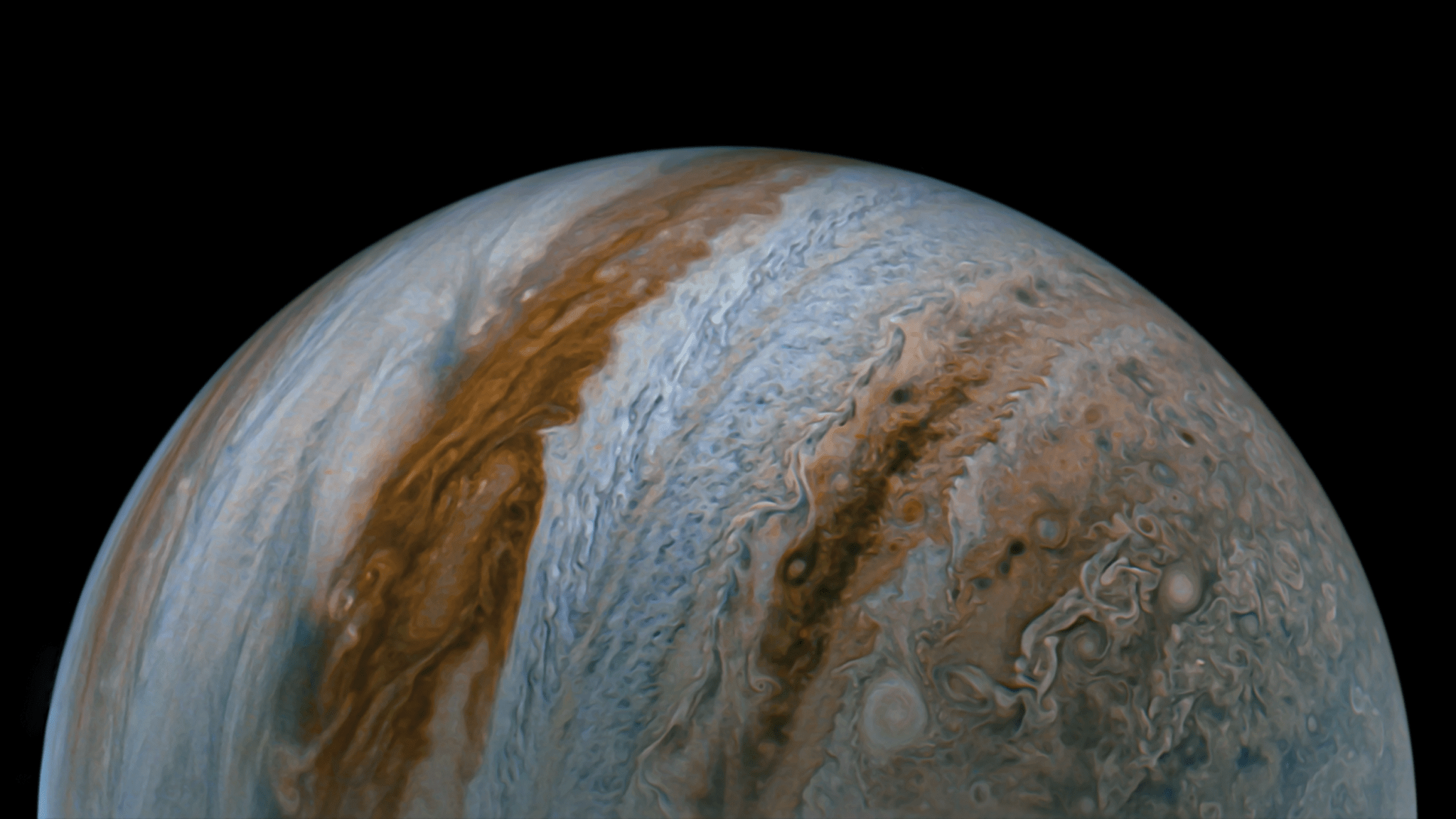
One way the Juno mission learns about the planet’s interior is via radio science. Using NASA’s Deep Space Network antennas, scientists track the spacecraft’s radio signal as Juno flies past Jupiter at speeds near 130,000 mph, measuring tiny changes in its velocity – as small as 0.01 millimeter per second. Those changes are caused by variations in the planet’s gravity field, and by measuring them, the mission can essentially see into Jupiter’s atmosphere.
Such measurements have led to numerous discoveries, including the existence of a dilute core deep within Jupiter and the depth of the planet’s zones and belts, which extend from the cloud tops down approximately 1,860 miles.
To determine the location and cylindrical nature of the winds, the study’s authors applied a mathematical technique that models gravitational variations and surface elevations of rocky planets like Earth. At Jupiter, the technique can be used to accurately map winds at depth. Using the high-precision Juno data, the authors were able to generate a four-fold increase in the resolution over previous models created with data from NASA’s trailblazing Jovian explorers Voyager and Galileo.
“We applied a constraining technique developed for sparse data sets on terrestrial planets to process the Juno data,” said Ryan Park, a Juno scientist and lead of the mission’s gravity science investigation from NASA’s Jet Propulsion Laboratory. “This is the first time such a technique has been applied to an outer planet.”
The measurements of the gravity field matched a two-decade-old model that determined Jupiter’s powerful east-west zonal flows extend from the cloud-level white and red zones and belts inward. But the measurements also revealed that rather than extending in every direction like a radiating sphere, the zonal flows go inward, cylindrically, and are oriented along the direction of Jupiter’s rotation axis. How Jupiter’s deep atmospheric winds are structured has been in debated since the 1970s, and the Juno mission has now settled the debate.
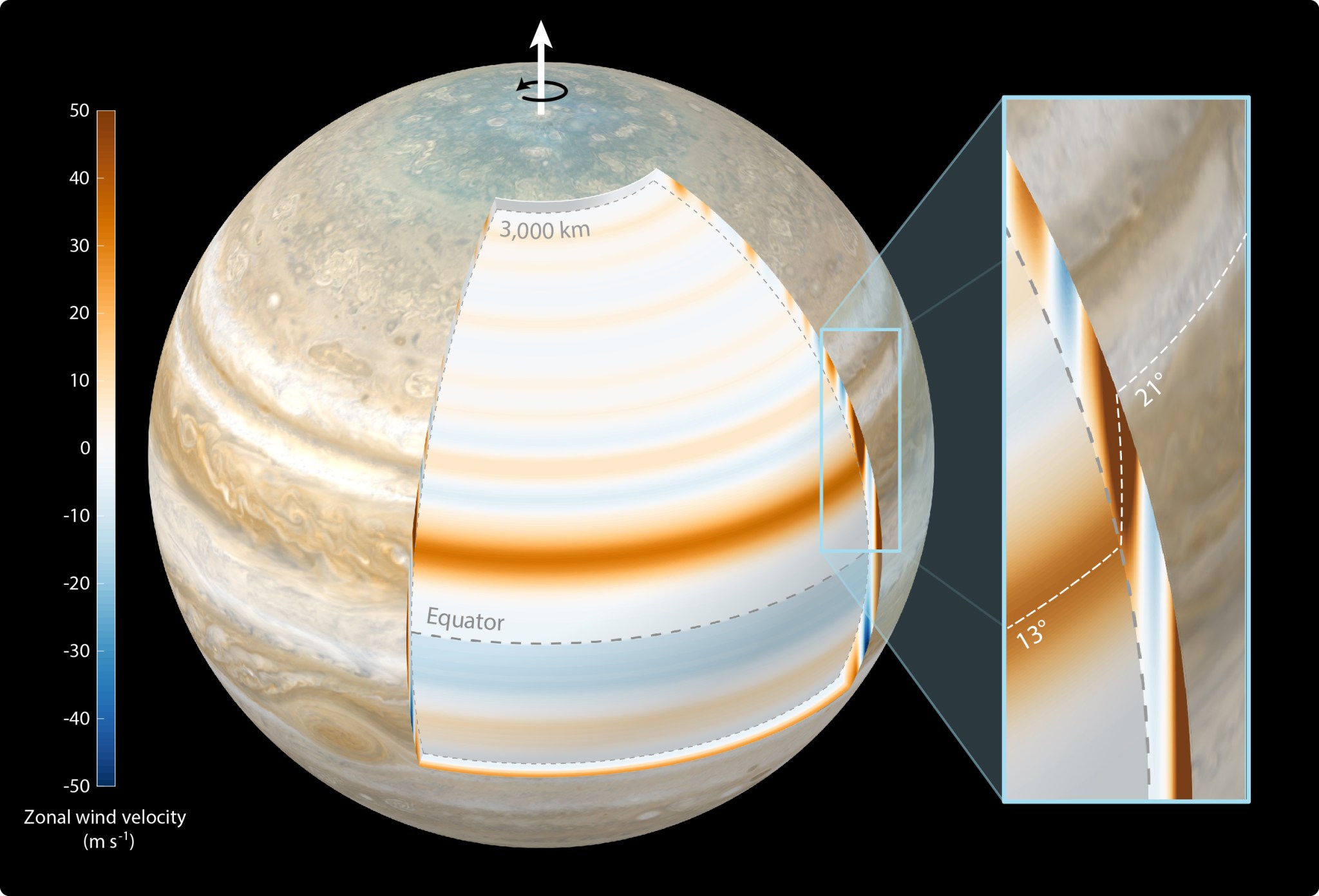
“All 40 gravity coefficients measured by Juno matched our previous calculations of what we expect the gravity field to be if the winds penetrate inward on cylinders,” said Yohai Kaspi of the Weizmann Institute of Science in Israel, the study’s lead author and a Juno co-investigator. “When we realized all 40 numbers exactly match our calculations, it felt like winning the lottery.”
Along with bettering the current understanding of Jupiter’s internal structure and origin, the new gravity model application could be used to gain more insight into other planetary atmospheres.
Juno is currently in an extended mission. Along with flybys of Jupiter, the solar-powered spacecraft has completed a series of flybys of the planet’s icy moons Ganymede and Europa and is in the midst of several close flybys of Io. The Dec. 30 flyby of Io will be the closest to date, coming within about 930 miles of its volcano-festooned surface.
“As Juno’s journey progresses, we’re achieving scientific outcomes that truly define a new Jupiter and that likely are relevant for all giant planets, both within our solar system and beyond,” said Scott Bolton, the principal investigator of the Juno mission at the Southwest Research Institute in San Antonio. “The resolution of the newly determined gravity field is remarkably similar to the accuracy we estimated 20 years ago. It is great to see such agreement between our prediction and our results.”
NASA’s Jet Propulsion Laboratory, a division of Caltech, manages the Juno mission for the principal investigator, Scott J. Bolton, of the Southwest Research Institute in San Antonio. Juno is part of NASA’s New Frontiers Program, which is managed at NASA’s Marshall Space Flight Center for the agency’s Science Mission Directorate. Lockheed Martin Space in Denver built and operates the spacecraft.
Read more about Juno.
























